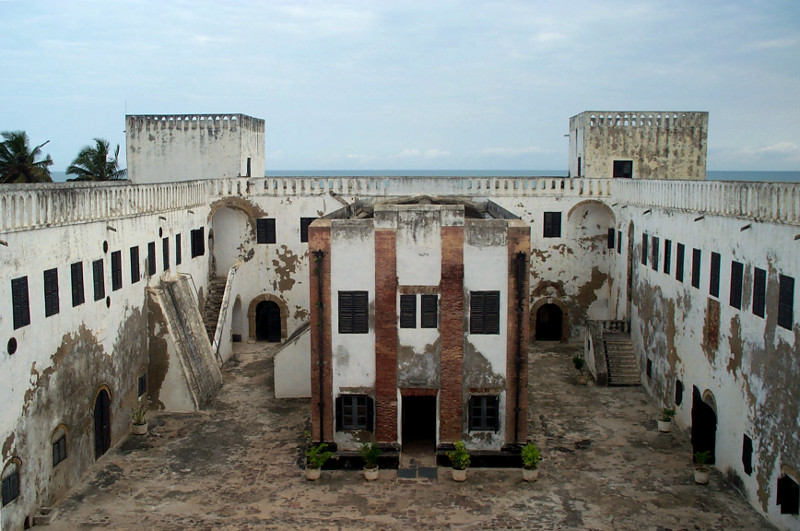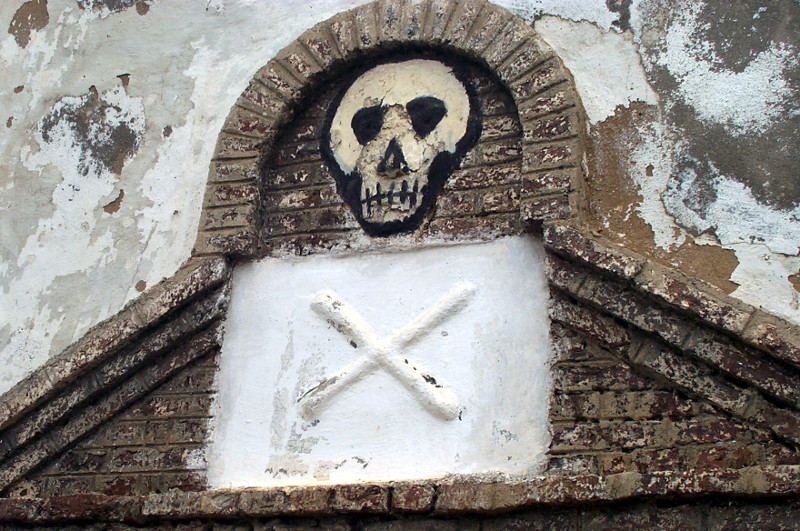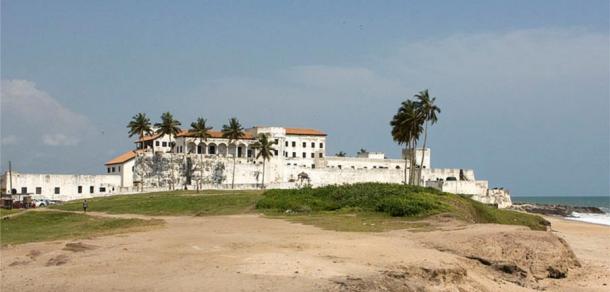
Welankuntewaken! Halito! Osiyo!
While doing quite a bit of reflection, it led me to reflect on the invaluable information that Joel Augustus Rogers shared about the Barbary slave trade from the 1400s to the 1800s of pale people(so called “white” people) in particular page 111 of Joel Augustus Rogers’s book ‘Sex and Race, Volume 1: Negro-Caucasian Mixing in All Ages’, which we should keep in mind that the Barbary slave trade affected millions of pale people, and thus rendering them totally incapable of coming to west Africa and central Africa to enslave Africans to in turn bring them to America:
 Well, when I looked up the Elmina castle, it was built in 1482 by the “Portuguese,” thus long before the creation of the African trans-Atlantic slave trade scam, and would have only been built by the moors since Spain and Portugal border each other and at that time period Portugal didn’t exist. The country Portugal was created on the 5th of October in 1910 while Spain was created on the 19th of March in 1812. So, all of that land was simply Andalusia. Pale people didn’t have knowledge of architecture, ship building, soap, and endless other things at that time. The Elmina castle was therefore used as a trading post for gold.
Well, when I looked up the Elmina castle, it was built in 1482 by the “Portuguese,” thus long before the creation of the African trans-Atlantic slave trade scam, and would have only been built by the moors since Spain and Portugal border each other and at that time period Portugal didn’t exist. The country Portugal was created on the 5th of October in 1910 while Spain was created on the 19th of March in 1812. So, all of that land was simply Andalusia. Pale people didn’t have knowledge of architecture, ship building, soap, and endless other things at that time. The Elmina castle was therefore used as a trading post for gold.
When we reflect on that, they would have us just look at the situation of “Portuguese” and immediately think pale people. But when we reflect on the reality of the situation, it brings us to think about how again from the 1400s onto the 1800s, it was only the moors that engaged in international trade in Africa especially with gold and slaves (pale people), which we should keep in mind that the word “slave” comes from the term slav, and in turn “slav” is another term for pale people. So, here it is that pale people switched the situation of them being sold as slaves with autochthonous Americans as well as dramatizing the situation of the Elmina castle into slavery when the real issue was its original usage for the international gold trade which was directly connected at that time to the moors:  “Renowned as the first major European construction in tropical Africa, St. George’s Castle, in the town of Elmina in the Central Region of Ghana, was founded by the Portuguese in 1482. The site of the Castle was selected by Portuguese navigators, as it was advantageously located at the end of a narrow promontory , a stone’s throw away from both the Atlantic Ocean and the Benya River. The lee of the low headland provided an excellent natural harbour. St George’s Castle or ‘Sao Jorge da Mina’, after the patron-saint of Portugal, as the castle was known to the Portuguese, afforded the Portuguese a trade monopoly in the area, with unrivalled access to the region’s gold. The sheer magnitude of trade volumes resulted in labour challenges, as navies were unable to convey the large quantities of European goods to all markets. The importation of slaves from Benin in exchange for gold and ivory in the early 16th century was the identified solution. However, not long after, the influx of superior gold from Mexico into Europe caused gold prices to plummet rapidly. The economically distraught Portuguese were easily ousted from Elmina in 1637 by the Dutch. The main Dutch trades were gold and slaves; they reconstructed the castle between 1770 and 1775. Until 1872, the castle served as the focal coordinating point for Dutch Gold Coast activities. In 1682, the author Jean Barbot described St. George’s Castle as having ‘no equal on all the coast of Guinea’ , with respect to beauty and strength.”
“Renowned as the first major European construction in tropical Africa, St. George’s Castle, in the town of Elmina in the Central Region of Ghana, was founded by the Portuguese in 1482. The site of the Castle was selected by Portuguese navigators, as it was advantageously located at the end of a narrow promontory , a stone’s throw away from both the Atlantic Ocean and the Benya River. The lee of the low headland provided an excellent natural harbour. St George’s Castle or ‘Sao Jorge da Mina’, after the patron-saint of Portugal, as the castle was known to the Portuguese, afforded the Portuguese a trade monopoly in the area, with unrivalled access to the region’s gold. The sheer magnitude of trade volumes resulted in labour challenges, as navies were unable to convey the large quantities of European goods to all markets. The importation of slaves from Benin in exchange for gold and ivory in the early 16th century was the identified solution. However, not long after, the influx of superior gold from Mexico into Europe caused gold prices to plummet rapidly. The economically distraught Portuguese were easily ousted from Elmina in 1637 by the Dutch. The main Dutch trades were gold and slaves; they reconstructed the castle between 1770 and 1775. Until 1872, the castle served as the focal coordinating point for Dutch Gold Coast activities. In 1682, the author Jean Barbot described St. George’s Castle as having ‘no equal on all the coast of Guinea’ , with respect to beauty and strength.”
http://www.ghanamuseums.org/forts/fort-st-george-castle.php
Based on the information Ghana shared above, their so called trans-atlantic slave trade would have only been 5 years even though in reality the moors never came to west Africa and central Africa enslaving fellow Africans to bring them to America, which we should keep in mind that America is from the northern most tip of Greenland onto the southern most tip of Argentina. The actual colonization of Ghana by pale people is rather recent. Here is a drawing of the Elmina castle that was made by Dutch cartographer Joan Blaeu between 1665-1668 and in turn published in the 8 volume facsimile entitled ‘The Atlas Blaeu-Van der Hem’:

https://en.wikipedia.org/wiki/Elmina_Castle#/media/File:ElMina_AtlasBlaeuvanderHem.jpg
When looking at it, the castle has no port nor does it indicate the usage of slave ships at the castle, which in turn is fascinating because up to now Elmina castle still does not even have a port. One may ask why is having a port system important. It’s important because according to the African trans-Atlantic slave trade story, 12 million were forcefully taken although when I went to Goree island in 2012, the tour guide stated that 300 million were taken from Senegal and brought to America although the population of Senegal is only 13 million now (and at the time was 12 million). Subsequently, whether we go with the lowest number of 12 million or all the way up to 300 million, it still would lead into at least hundreds of thousands of slave ships, if not truly millions of slave ships, to attempt to accomplish such an objective as supposedly these ships could only carry 300-500 people, particularly the biggest ships.
So that would cause for them to have to have a very very organized port system that can support the entering and exiting of hundreds of thousands of slave ships, if not millions of slave ships, at the designated location (in this case Elmina castle) especially at the same time period of just 6 months to attempt to accomplish this objective before the hurricane season comes forth as the Atlantic ocean hurricane season lasts for 6 months: the 1st of June onto November 30. Otherwise if they would attempt to do that during hurricane season then they would very severely fail. This is also especially important for them to figure out since Elmina castle is marketed off as central to the African trans-Atlantic slave trade, and thus most people that would have suffered such genocide would be connected to Elmina castle. Ghana is simply using the Elmina castle to fuel their economy as tourism is a crucial component of what they are using to empower their economy. They are very aware of the over one trillion dollar buying power of autochthonous Americans. As a result, in order to get some of that over trillion dollars, they took advantage of customizing the Elmina castle as central to the African trans-Atlantic slave trade story.
Not only that, but while I was reading page 38 of ‘African Names: Names from the African Continent for Children and Adults’ by Julia Stewart it states: “ELMINA (ehl-MEE-nah) A government-run rest house on the coast of Ghana that was originally a Portuguese-built fort in 1482 and later became a Dutch fort. Elmina means “the mine,” as derived from Portuguese.” https://books.google.com/books?id=nh3vAzbfk90C&lpg=PA38&dq=elmina%20means&pg=PA38#v=onepage&q=elmina%20means&f=false
And while looking up the etymology of the word “Mina,” it led me to check out further fascinating information: “From Late Latin mina, from Gaulish, from Proto-Celtic *mēnis (“ore, metal”). Noun mina f (plural mine) mine, land mine lead in pencils mine which produces ore Related terms minare minerale miniera Anagrams[edit] amni, iman, mani” https://en.wiktionary.org/wiki/mina#Italian
And interestingly, oro means gold in Spanish while ouro means gold in Portuguese. So, this would therefore mean that Elmina caste means “Castle that was designated for that in which was mined” (i.e. gold) and “Castle with gold”. Therefore, as I reflect more about the information about Elmina castle, it explains how is it that Ghana is also historically referred to as the “Gold Coast”.
“The Portuguese Gold Coast was a Portuguese colony on the West African Gold Coast (present day Ghana) on the Gulf of Guinea. The Portuguese established the following settlements on the Gold Coast from January 21, 1482: Fort São Jorge da Mina de Ouro, modern Elmina: January 21, 1482 – August 28–9, 1637; this became the capital.” https://en.wikipedia.org/wiki/Portuguese_Gold_Coast
Fort São Jorge da Mina de Ouro = Fort Saint George’s gold mine.











